NCERT Solutions For Class 3 Maths Chapter 14 - Rupees and Paise
Rupees and Paise deals with the concept of money. This chapter have exercises on adding and subtracting amounts, converting rupee to paise, rate charts and bills. The solutions for Math-Magic Chapter-14 have been created and verified by our experienced subject matter experts, according to the CBSE syllabus and guidelines of NCERT. For practice, our subject matter experts have created very interactive, activity-based, and Image-based worksheets on these topics to enhance learning Download Chapter 14 Rupees and Paise in PDF format for free here.
Download PDF For NCERT Solutions for Maths Rupees and Paise
The NCERT Solutions For Class 3 Maths Chapter 14 - Rupees and Paise are tailored to help the students master the concepts that are key to success in their classrooms. The solutions given in the PDF are developed by experts and correlate with the CBSE syllabus of 2023-2024. These solutions provide thorough explanations with a step-by-step approach to solving problems. Students can easily get a hold of the subject and learn the basics with a deeper understanding. Additionally, they can practice better, be confident, and perform well in their examinations with the support of this PDF.
Download PDF
Access Answers to NCERT Solutions For Class 3 Maths Chapter 14 - Rupees and Paise
Students can access the NCERT Solutions For Class 3 Maths Chapter 14 - Rupees and Paise. Curated by experts according to the CBSE syllabus for 2023–2024, these step-by-step solutions make Maths much easier to understand and learn for the students. These solutions can be used in practice by students to attain skills in solving problems, reinforce important learning objectives, and be well-prepared for tests.
Money Game
Write the amounts of money shown by the notes and coins around yourself
a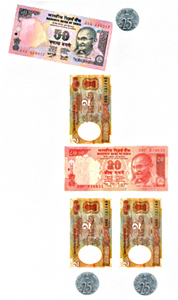
b
c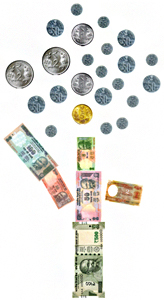
d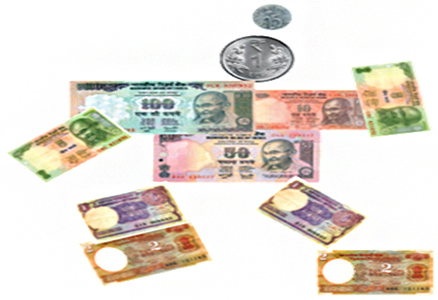
a.
| Notes and Coins | Number of Notes and Coins | Amount |
| 50-rupee | 1 | 50-rupee |
| 20-rupee | 1 | 20-rupee |
| 2-rupee | 3 | 3 × 2 = Rs 6 |
| 25-paisa | 3 | 3 × 25 =75 paise |
Hence, the total amount shown is: Rs 50 + Rs 20 + Rs 6 + 75 Paisa = Rs 76 and 75 paise
b. 100 paise = 1 rupee
| Notes and Coins | Number of Notes and Coins | Amount |
| 20-rupee | 1 | Rs 20 |
| 2-rupee | 5 | 2 × 5 = Rs 10 |
| 1-rupee | 1 | 2 × 5 = Rs 10 |
| 50-paisa | 7 | 50 × 7 = 350 = Rs 3 and 50 paise |
| 25-paisa | 5 | 5 × 25 = 125 = Rs 1 and 25 paise |
Hence, the total amount shown is:
Rs 20 + Rs10 + Rs 1 + Rs 3 + Rs 1 + 50 paise + 25 Paise
= Rs 35 and 75 paise
c. 100 paise = 1 rupee
| Notes and Coins | Number of Notes and Coins | Amount |
| Rs 500 | 1 | Rs 500 |
| Rs 100 | 1 | Rs 100 |
| Rs 50 | 1 | Rs 50 |
| Rs 10 | 1 | Rs 10 |
| Rs 5 | 2 | 5 × 2 = Rs 10 |
| Rs 2 | 3 | 2 × 3 = Rs 6 |
| Rs 1 | 2 | 1 × 2 = Rs 2 |
| 50-paisa | 7 | 7 × 50 = 350 = Rs 3 and 50 paise |
| 25- paisa | 11 | 11 × 25 = 275 = Rs 2 and 75 paise |
Hence, the total amount shown is:
Rs 500 + Rs 100 + Rs 50 + Rs 10 + Rs 10 + Rs 6 + Rs 2 + Rs 3 + Rs 2 + 50 paise + 75 paise
= Rs 683 and 125 paise
= Rs 684 and 25 paise
d.
| Notes and Coins | Number of Notes and Coins | Amount |
| Rs 100 | 1 | Rs 100 |
| Rs 50 | 1 | Rs 50 |
| Rs 10 | 1 | Rs 10 |
| Rs 5 | 2 | 2 × 5 = Rs 10 |
| Rs 2 | 2 | 2 × 2 = Rs 4 |
| Rs 1 | 3 | 3 ×1 = Rs 3 |
| 25-Paisa | 1 | 25-Paisa |
Hence, the total amount shown is:
Rs 100 + Rs 50 + Rs 10 + Rs 10 + Rs 4 + Rs 3 + 25 paise
= Rs 177 and 25 paise
Use notes and coins to show the following amounts of money (You can also keep some money in the purse you had made).
a. 4 rupees 75 paise
b. 78 rupees
c. 130 rupees
d. 8 rupees 75 paise
e. 53 rupees
Answers may vary. You can show the given amount by combining different notes and coins. Sample answers are:
a. Use four 1-rupee notes, one 50-paise coin, and one 25- paise coin to show 4 rupees 75 paise.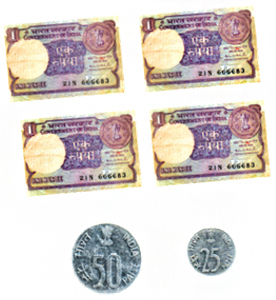
b. Use one 50-rupee note, one 20-rupee note, one 5-rupee note, one 2- rupee note, and one 1-rupee note to show 78 rupees.
c. Use one 100-rupee note, one 20-rupee note, and one 10-rupee note to show 130 rupees.
d. Use one 5-rupee note, one 2-rupee note, one 1-rupee note, one 50- paise coin, and one 25-paise coin to show 8 rupees 75 paise.
e. Use one 50-rupee note, one 2-rupee note, and one 1-rupee note to show 53 rupees.
Shopping
Can you see a pattern in the way each block is repeated?Without using a pencil or paper, find out the cost of:
a. One ball and one toy car Rs ______
b. One notebook and two pencils Rs_______
c. Two bananas and a glass of milk Rs _______
d. One doll and a ball Rs________
e. One glass of lemon juice and a packet of biscuits Rs ________
Observe the blocks in the given image. Blocks are placed upwards and downwards in a pattern. So, there is a pattern.
a. See the cost of one ball and one toy car from the given picture and add mentally.
Rs 7 + Rs 15 = Rs 22
Hence, the correct answer is Rs 22.
b. To find the cost of 2 pencils, see the cost per pencil in the given picture and double it mentally.
2 × Rs 2.50 = Rs 5
Now, add the cost of one notebook to Rs
5 + 5 = 10
Hence, the correct answer is Rs 10.
c. To find the cost of 2 bananas, see the cost of one banana in the given picture and double it mentally.
2 × Rs 1.50 = Rs 3
Now add the cost of a glass of milk to Rs 3
3 + 3. 50 = 6. 50
Hence, the correct answer is Rs 6.50.
d. See the cost of a doll and a ball in the given picture and add them mentally.
8 + 7 = 15
Hence, the correct answer is Rs 15.
e. See the cost of one glass of lemon juice and a packet of biscuits in the given picture and add them mentally.
3 + 4.50 = 7.50
Hence, the correct answer is Rs 7.50.
Find out the total cost of:
a. One toy giraffe, one copy and a glass of lemon juice
b. One glass of milk, one packet of biscuits and a banana
c. One notebook, two pencils and two erasers
d. Two tops, three toffees and two bananas
a. From the given picture, one giraffe is for Rs 6.50, one copy is for Rs 5, and one glass of lemon juice is for Rs 3. Add 6.50, 5, and 3 to find the total cost.
6.50 + 5 + 3 = 14.50
Hence, the correct answer is Rs 14.50.
b. From the given picture, a glass of milk is for Rs 3.50, one packet of biscuits is for Rs 4.50, and a banana is for Rs 1.50. Add the values to find the total cost.
3.50 + 4.50 + 1.50 = 9.50
Hence, the correct answer is Rs 9.50.
c. From the given picture, a notebook is for Rs 5, a pencil is for Rs. 2.50, so two pencils will cost Rs 5.
An eraser is for Rs 1, so 2 erasers will cost Rs 2 Add these values to find the total cost.
5 + 5 + 2 = 12
Hence, the correct answer is Rs 12.
d.From the given picture, one top is for Rs 2. So, the cost of 2 tops is
2 × Rs 2 = Rs 4
One toffee is for Rs. 0.50. So, the cost of 3 toffees is:
3 × Rs 0.50 = Rs 1.50
One banana is for Rs 1.50. So, the cost of 2 bananas is 2 × Rs 1.50 = Rs 3.00.
Now, add the costs.
4 + 1.50 + 3.00 = 8.50
Hence, the correct answer is Rs 8.50.
What can you buy if you have a twenty-rupee note?
Do it by yourself. Answers can vary. Sample answers are:
a. A ball, a doll, and a notebook.
Rs 7 + Rs 8 + Rs 5 = Rs 20
b. A top, a car, and a glass of lemon juice.
Rs 2 + Rs 15 + Rs 3 = Rs 20
c. A car, a glass of milk, and a banana.
Rs 15 + Rs 3.50 + Rs 1.50 = Rs 20
d. Two giraffes, two pencils, and two rubbers.
Rs 13 + Rs 5 + Rs 1 = Rs 20
You need to make a cash memo for the things you bought. Before adding, first guess how much money will be needed. Then find the total and check your guess.
The complete patterns are shown below.Do it by yourself as directed. Following is a sample answer. We bought a ball, a doll, and a notebook with 20 rupees. Following is the cash memo.
You have 30 rupees with you. Find out how much money will be left after buying the following items:
a. One ball, one doll, and one toy giraffe. Total cost _______. Money left_______
b. Two bananas, one pack of biscuits, and two glasses of lemon juice. Total cost ________. Money left _______
c. Three notebooks, two pencils, and two erasers. Total cost _________. Money left _________.
a. Cost of one ball, one doll, and one giraffe are Rs 7, Rs 8, and Rs 6.50 respectively.
Total cost = Rs7 + Rs 8 + Rs 6.50 = Rs 21.50.
From 30 rupees the money left is:
Rs 30 – Rs 21.50 = Rs 8.50
Hence, total cost Rs 21.50. Money left Rs 8.50.
b. Cost of Two bananas, one pack of biscuits, and two glasses of juice are Rs 3.00, Rs 4.50, and Rs 6.00, respectively.
Total cost = Rs 3 + Rs 4.50 + Rs 6 = Rs 9 + Rs 4.50 = Rs 13.50
From 30 rupees, the money left is:
Rs 30 – Rs13.50 = Rs 16.50
Hence, total cost Rs13.50. Money left Rs16.50.
c. Cost of three notebooks, two pencils, and two erasers are Rs 15, Rs 5.00, and Rs 2, respectively.
Therefore, the total cost = Rs 15 + Rs 5 + Rs 2 = Rs 20 + Rs2 = Rs 22
From 30 rupees, the money left is:
Rs30 – Rs22 = Rs 8
Hence, total cost Rs 22. Money left Rs 8.
Check the cash memos and correct them if you find a mistake.
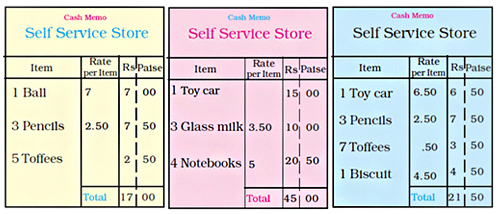
The correct answer is:

Add the following:

The correct answers are:

Subtract the following:

The correct answers are:

Practice Time
Three friends wanted to buy a cricket bat and ball. Bina had Rs 48.50, Raman had Rs 55.50 and Venu had Rs 38.00. How much money did they have in all?
Add the given amounts to find the total.
Rs 48.50 + Rs 55.50 + Rs 38.00 = Rs 142.00
Hence, in total they have Rs 142.
Gita and her friends went shopping. She bought things for Rs 58, Rs 37, and Rs 22. Gita had a hundred-rupee note. How much money should she borrow from her friends to pay the bill?
She bought the things for Rs 58, Rs 37, and Rs 22. Total amount spent is:
Rs 58 + Rs 37 + Rs 22 = Rs117
Since she had Rs 100, subtract Rs 100 from Rs 117 to find the difference.
Rs 117 – Rs 100 = Rs 17
Hence, she should borrow Rs 17.
Mumbai News
Children Freed from Factory
10 young children working in a bangle factory were set free today. A news reporter and the police found them in a sad condition. The factory made the children work very hard. It paid them only Rs 80 a day. The children are happy to go back to their homes in their village. They will go to a special school so that they can learn to study like other children their age. By making children work, the factory tries to save money. The police will now take action. Let us see how much money the factory tries to save.
Money 1 older worker should get = Rs 513 a day
Money 1 child is paid = Rs 80 a day
On 1 person the factory saves Rs 513 – _____ = Rs 433 a day
On 10 persons the factory saves
Rs 433 × 10 = Rs _____ a day.
To find the savings of the company on a child per day, subtract the money a child gets for a day from the money an older person gets for a day.
Rs 513 − Rs 80 = Rs 433
Therefore, the correct answer is:
Rs 513 – Rs 80 = Rs 433 a day
Now, to find the savings of the company on 10 children per day, multiply Rs 433 by 10.
Rs 433 × 10 = Rs 4330.
Hence, the factory saves Rs 4330 per day on 10 children.
Subtract 62.50 from 100 to find the remaining amount
Subtract 62.50 from 100 to find the remaining amount.
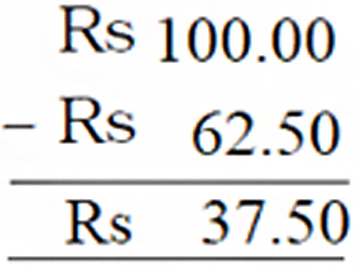
Hence, he will get back Rs 37.50.
Find Out
In your area there are shops or factories where young children are made to work? Talk to some of these children. How much are they paid there?
Do it by yourself. Child labour is a crime.
Train Journey
This train goes from New Jalpaiguri to Guwahati. On its way, it stops at New Mal, Alipurduar and Goalpara stations. The cost of a rail ticket to different stations is given in the table.
Find the distance:
a. From New Mal to Guwahati _____
b. Between New Mal and Goalpara______
c. From Alipurduar to Guwahati______
d. Between New Mal and Alipurduar______
e. From Goalpara to Guwahati_______
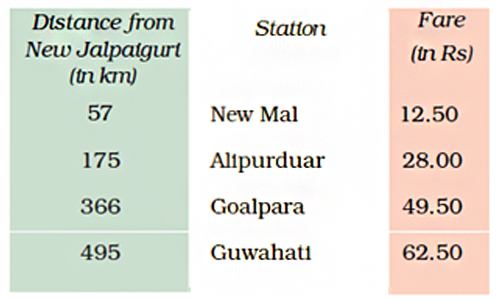
a. New Mal is 57 km from New Jalpaiguri, and Guwahati is 495 km from New Jalpaiguri. Subtract 57 from 495 to get the distance between New Mal and Guwahati.
495 – 57 = 438
Hence, the correct answer is 438 km.
b. New Mal is 57 km from New Jalpaiguri, and Goalpara is 366 km from New Jalpaiguri. Subtract 57 from 366 to get the distance between New Mal and Goalpara.
366 – 57 = 309
Hence, the correct answer is 309 km.
c. Alipurduar is 175 km from New Jalpaiguri, and Guwahati is 495 km from New Jalpaiguri. Subtract 175 from 495 to get the distance between Alipurduar and Guwahati.
435 – 175 =
Hence, the correct answer is 320 km.
d. Alipurduar is 175 km from New Jalpaiguri, and New Mal is 57 km from New Jalpaiguri. Subtract 57 from 175 to get the distance between Alipurduar and New Mal.
175 – 57 = 118
Hence, the correct answer is 118 km.
e. Goalpara is 366 km from New Jalpaiguri, and Guwahati is 495 km from New Jalpaiguri. Subtract 366 from 495 to get the distance between Goalpara and Guwahati.
495 – 366 = 129
Hence, the correct answer is 129 km
Find the cost of tickets:
a. Bhupen is going from New Jalpaiguri to Alipurduar. What is the cost of his ticket?
b. Indira has to go from New Jalpaiguri to Goalpara. How much does she pay for the ticket?
c. Debu, Shoma and Gobind are going from New Jalpaiguri to New Mal. What amount will they pay for three tickets? They give a Rs 50 note for the tickets. How much money will they get back?
a From the given table, the fare is Rs 28.
b. From the given table, the fare is Rs 49.50.
c. From the given table the fare of 1 ticket is Rs 12.50. Therefore, the fare for 3 tickets is:
Rs 12.50 + Rs12.50 + Rs12. 50 = Rs 37.50
If they give 50 rupees note for the tickets then they will get back
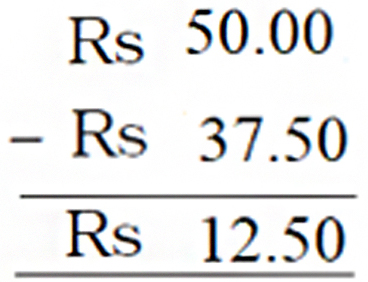
Hence the correct answer is Rs 12.50.
Frequently Asked Questions
The NCERT solution for Class 3 Chapter 14: Rupees and Paise is important as it provides a structured approach to learning, ensuring that students develop a strong understanding of foundational concepts early in their academic journey. By mastering these basics, students can build confidence and readiness for tackling more difficult concepts in their further education.
Yes, the NCERT solution for Class 3 Chapter 14: Rupees and Paise is quite useful for students in preparing for their exams. The solutions are simple, clear, and concise allowing students to understand them better. Rupees and Paise additionally, they can solve the practice questions and exercises that allow them to get exam-ready in no Rupees and Paise.
You can get all the NCERT solutions for Class 3 Maths Chapter 14 from the official website of the Orchids International School. These solutions are tailored by subject matter experts and are very easy to understand.
Yes, students must practice all the questions provided in the NCERT solution for Class 3 Maths Chapter 14: Rupees and Paise as it will help them gain a comprehensive understanding of the concept, identify their weak areas, and strengthen their preparation.
Students can utilize the NCERT solution for Class 3 Maths Chapter 14 by practicing the solutions regularly. Solve the exercises and practice questions given in the solution.

